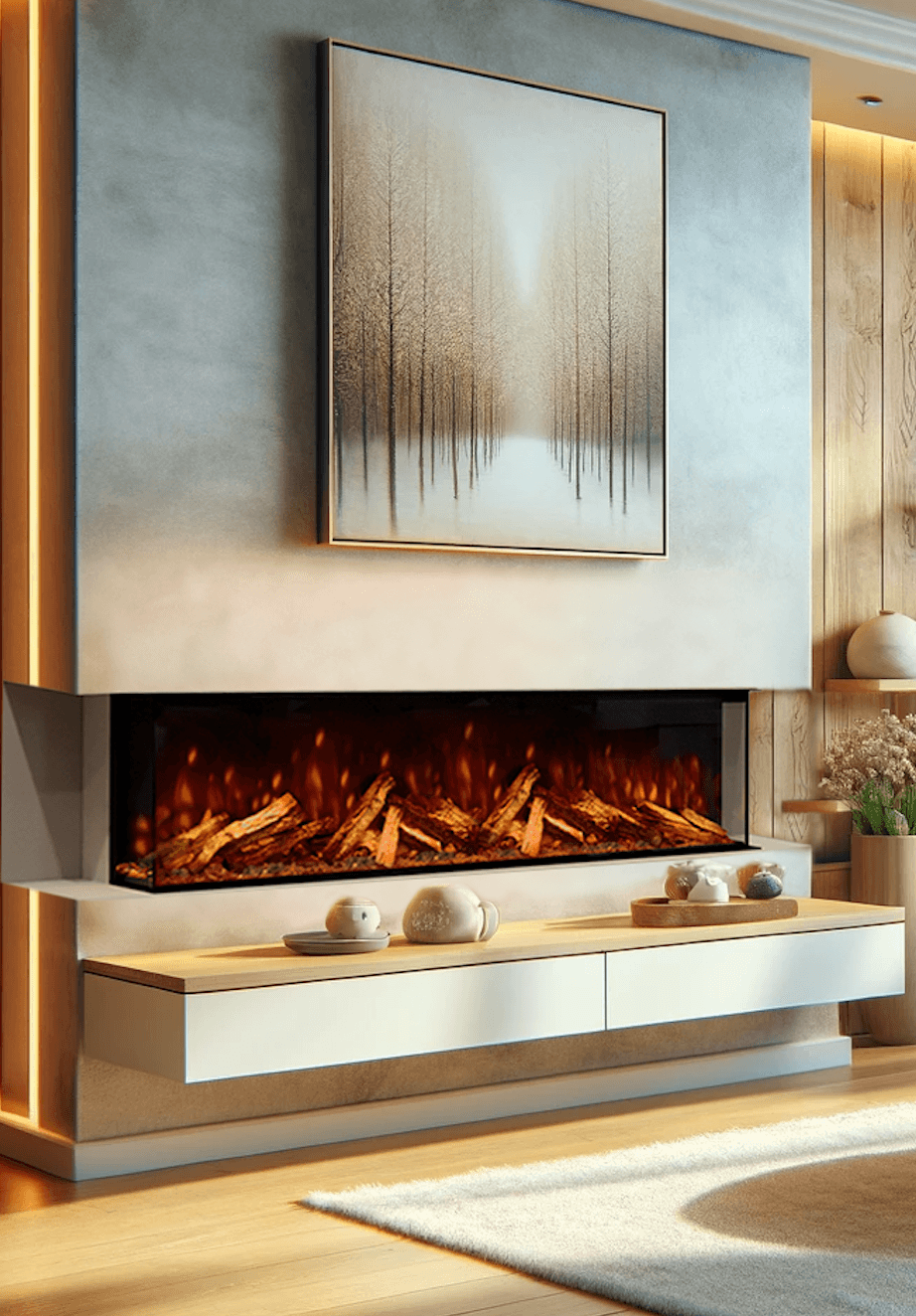
Do electric fireplaces need a vent?
Using a realistic flame effect and a heating element, electric fireplaces reproduce every desirable aspect of a real fireplace. They can look and feel exactly like a real fireplace, having a flickering, 3D flame, and giving off tangible heat. This may make you question whether an electric fireplace needs a vent or chimney like a real fireplace would too.
Electric fireplaces do not need a vent, nor do they need a chimney or any other type of ventilation system.
The flames and heat in an electric fireplace aren’t real, instead being a series of internal mechanisms powered by electricity. So, as they lack real burning fuel, electric fireplaces don’t give off any harmful byproducts like smoke or carbon monoxide. They also convert 100% of the energy they draw into usable heat meaning no waste heat is produced. For these reasons, it isn’t necessary to install any type of ventilation system around an electric fireplace.
What is an electric fireplace and how does it work?
Electric fireplaces are an alternative option to traditional fuel-burning fireplaces like wood or gas.
What sets electric fireplaces apart from their traditional counterparts is that they run solely on electricity; they create the look and feel of a real burning fireplace, doing so without any real fire or burning fuel.
In place of a real fire, electric fireplaces involve a series of internal mechanisms that are powered by electricity. The visual effect of the fire in an electric fireplace is nothing more than an optical illusion; although the fire may look highly realistic, electric fireplaces don’t contain actual flames. To create this effect, the most common mechanism involves a series of rotating mirrors and an LED bulb within the fireplace unit. The light reflects off the mirrors, generating the visual effect of real flickering flames. Modern models of electric fireplaces may instead use a digital screen to achieve this effect.
To emulate the warmth that a real fireplace would produce, electric fireplaces also contain some form of heating mechanism. This mechanism could be one of two types, with units using either a fan-forced heater or infrared heating technology. Fan-forced heaters work similarly to conventional space heaters; they take in cold air from the room and pass it over a heated coil, before expelling the warm air back into the room. Infrared models instead radiate heat out into the room via infrared waves.
Regardless of the model, all-electric fireplaces run entirely on electricity. They are simple to install as they can be used as soon as they’re connected to a power source. This could be as straightforward as plugging the fireplace into a regular power socket and turning it on; alternatively, you can wire the fireplace directly into your home electrics.
Do electric fireplaces need a vent?
No, electric fireplaces do not need a vent, chimney, or any other type of ventilation.
You can install an electric fireplace anywhere in your home providing that there’s an available power outlet nearby. Apart from this, no other structural additions would be necessary when installing your electric fireplace.
With traditional fuel-burning fireplaces, some form of ventilation is necessary; any fireplace that involves actual burning fuel would create a serious health and safety hazard without ventilation. The burning of wood or gas creates harmful byproducts like smoke, ash, and carbon monoxide. Without ventilation, these fumes would pour into your home, posing a significant health risk to anyone in the building. Ventilation is also necessary to channel the excess heat that is lost via these fumes.
Electric fireplaces, on the other hand, do not have the same requirements for ventilation. As we’ve explained, these fireplaces do not involve any sort of burning fuel or actual fire. They therefore give off no emissions or byproducts during operation. On top of this, electric fireplaces convert 100% of the energy that they draw into producing usable heat for the room. These benefits make it possible to use an electric fireplace anywhere in your home without the necessity of a vent or chimney.
What are the other advantages of an electric fireplace?
In addition to not needing ventilation, there are a host of other advantages to using an electric fireplace in place of a real one.
Easy to install
All that is required for an electric fireplace to work properly is an available power outlet. This makes it possible to set up your electric fireplace yourself and have it running within minutes. You simply need to connect it to a power source, switch it on, and your fireplace will begin working instantly.
Little to no maintenance required
No matter how much use they get, electric fireplaces require little to no maintenance to remain in safe working condition. As they don’t produce any byproducts, there won’t be a vent or chimney to maintain. You don’t have to spend time clearing out ash or cleaning around the hearth. At most, you may need to clean your electric fireplace occasionally with a microfibre cloth if the unit becomes dusty.
No need to purchase fuel
Traditional fuel-burning fireplaces require a constant stock of fuel, whether that’s wood, gas, or coal. These materials can be costly to purchase and laborious to transport from the supplier to your fireplace. And, if you run out of fuel, there’s no other possible way to use a fuel-burning fireplace. This is never an issue with electric fireplaces, as no fuel is necessary to create the flame effect or heat. The only rare occasion that may prevent you from using your electric fireplace is if there’s a power cut to your home; otherwise, they will run as and when you need them to at the touch of a button.
Less expensive to purchase
It will cost you a lot less to purchase and install an electric fireplace compared to a traditional type. The units themselves are generally much cheaper than traditional fireplaces; also, you won’t need to spend money on installing a vent, chimney, or any other form of ventilation system. As there’s a range of models to choose from, you’ll be able to find an electric fireplace within your budget.
Provides a cost-effective way to heat your home
Longer-term, electric fireplaces are more cost-effective than other types of fireplaces to heat your home. You can use an electric fireplace to provide ‘supplemental heat’ to the room you’re in; this would enable you to keep the rest of your home at a lower temperature, saving you money on your heating bills. Electric fireplaces use relatively little energy to run and are much cheaper across the board than traditional fuel-burning fireplaces.
Much safer than traditional fireplaces
Traditional fuel-burning fireplaces can pose a significant safety risk, especially to young children and pets. These fireplaces get very hot during use, and the fire creates a potential hazard to your home and household members. Lacking a real fire, electric fireplaces do not come with these safety hazards. The only minor risk with an electric fireplace is that the glass pane can become warm to the touch; even so, it will never reach a temperature hot enough to cause a burn-on contact.
Ability to use flame-only setting
The flame effect and heating element in an electric fireplace are two separate mechanisms. Thanks to this, most models of electric fireplaces come with a flame-only functionality; this setting enables you to use the flame effect of the fireplace without turning on the heater. You can therefore make use of your electric fireplace all year, even in the warmer months when heating is unnecessary.
Thermostat functionality
Another key feature of electric fireplaces is that they often come with thermostat functionality. These fireplaces contain a thermostat that will automatically switch off the heater once the room reaches the desired temperature. This functionality also protects the unit from overheating if you forget to switch it off, or malfunctioning in a power surge.
Where can you install an electric fireplace?
You can install an electric fireplace pretty much anywhere on your property, including outdoor spaces.
Again, all you need for an electric fireplace is an available power source to connect it to your home electrics. Aside from this requirement, any type of room or space will be able to accommodate an electric fireplace safely.
Homeowners often install an electric fireplace in their living room to create a central focal point for the space. It’s also common to install an electric fireplace in a bedroom, game room, or basement; they’re a great addition to any room that would benefit from supplemental heat. For outdoor use, it's important that the fireplace has the right cable and is protected from rain by an overhang.
Can you use an electric fireplace in an apartment?
Yes, it’s both completely safe and legal to use an electric fireplace in an apartment.
As it lacks a real fire, an electric fireplace would pose no risk to your building or neighbours. You can therefore use an electric fireplace regardless of whether you’re a renter or homeowner. If you rent, you don’t need to ask permission from your landlord before installing an electric fireplace; your only responsibility is to use the unit safely to entirely negate the risk of a fire.
Can you leave an electric fireplace on overnight?
In theory, you could leave an electric fireplace on overnight.
However, this would go against the general safety recommendations for the unit.
All electric fireplace models will come with a manual stating that you should never leave the fireplace on while unattended. The term ‘unattended’ applies to both when you leave the room and when you’re asleep. On the off chance that your electric fireplace malfunctions, you need to take action immediately. For instance, if a flammable material somehow came into contact with the heating element in the fireplace, it could cause a fire. It’s therefore best practice to switch off the fireplace when you’re not in the room or when going to sleep.
On top of this, leaving your electric fireplace on all night will cause your electricity bill to increase. This is a pointless waste of energy and money if no one is using the unit. If you’re cold at night, it’s better to throw an extra blanket on your bed than leave your fireplace on. Alternatively, consider using an electric blanket or hot water bottle to keep you warm at night.

